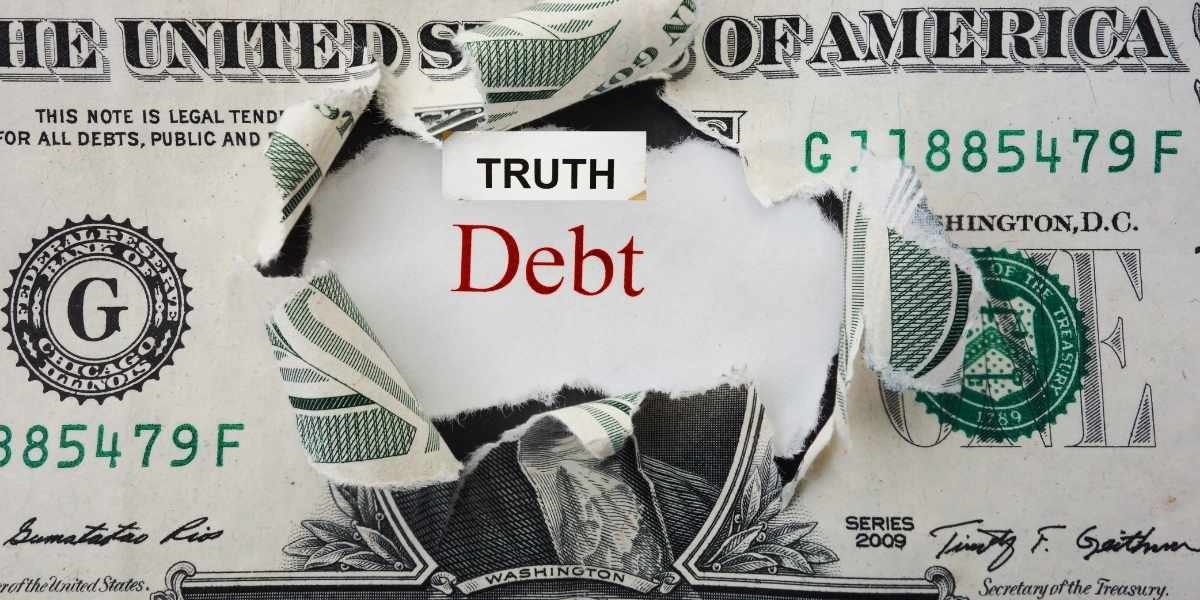
If you’re like most Americans, you probably carry some form of debt—whether it’s credit cards, car payments, student loans, or a mortgage. In fact, the average U.S. household with credit card debt owes over $5,000, and total consumer debt recently surpassed $16 trillion.
We’ve been conditioned to believe that debt is simply a part of life, something to manage rather than eliminate. But what if everything you’ve been told about debt is wrong? What if these common beliefs are actually costing you thousands of dollars in interest, limiting your financial freedom, and keeping you trapped in a cycle of payments that could be avoided?
In this article, we’re going to expose the 10 most damaging debt myths that are holding you back from true financial freedom. These aren’t just abstract concepts—I’ve seen firsthand how believing these myths can derail someone’s financial future.
Myth #1: “Good Debt vs. Bad Debt: All Debt Isn’t Created Equal”

One of the most dangerous beliefs about debt is the idea that some types are beneficial—or even necessary—for building wealth. The conventional wisdom goes like this: mortgages, student loans, and business loans are “good debt” because they invest in your future, while credit card debt and car loans are “bad debt” due to their high interest rates and depreciation.
The reality is that all debt carries risk and potential consequences. Even so-called “good debt” can become a financial albatross. Consider the housing crisis of 2008, when millions of Americans with “good” mortgage debt found themselves underwater on their homes, facing foreclosure, and financial ruin. Student loans, which now total over $1.7 trillion nationally, have become a crisis unto themselves, with borrowers delaying homeownership, marriage, and other life milestones because of their monthly payments.
My cousin Mike fell into this trap after medical school, believing his student loan debt was a worthwhile investment. Years later, with payments exceeding $1,500 monthly, he realized his “good debt” was preventing him from saving for retirement or buying a home. The truth is, debt—regardless of its perceived category—represents money you don’t own, payments that limit your financial flexibility, and risk that could undermine your stability.
Myth #2: “You Need a Credit Card to Build Credit”

Many people believe they must have credit cards to establish a credit history, and that without them, they’ll never qualify for important loans like mortgages or car loans. This myth has created a situation where Americans collectively carry over $800 billion in credit card debt, with many people holding balances they can’t pay off each month.
The truth is that credit cards aren’t the only way—or even the best way—to build credit. Secured credit cards, credit-builder loans, and becoming an authorized user on someone else’s account can all help establish credit without the temptation of revolving debt. Furthermore, your credit score is primarily based on your payment history, credit utilization, and length of credit history—not on having credit cards specifically.
When I first started out, I fell for this myth myself. I got my first credit card thinking I needed it to build credit, only to accumulate $3,000 in debt within a year. It took me three years to pay off, and I realized too late that I could have built credit through safer means. If you’re focused on building wealth, your energy should go into saving and investing, not managing credit card balances.
Myth #3: “Car Loans Are Inevitable”

The automobile industry has done an exceptional job convincing us that financing a new car is normal and expected. Dealerships tout low monthly payments and extended loan terms, making expensive vehicles seem affordable. But this myth has led Americans to collectively owe over $1.5 trillion in auto loan debt, with many people owing more on their cars than they’re worth (a situation called being “upside-down”).
Cars depreciate faster than almost any other major purchase—typically losing 20% of their value in the first year and 50% over five years. When you finance a car, you’re not just paying for the vehicle itself but also interest, extended warranties, and other add-ons that balloon the total cost. My friend Tom financed a $45,000 SUV with a 72-month loan at 4.5% interest, not realizing he’d pay over $5,000 extra in interest alone.
The smarter approach is to purchase reliable used vehicles with cash or short-term financing. By saving aggressively and buying cars that are two to three years old, you can avoid depreciation loss while still getting a quality vehicle. Challenge yourself to drive each car for at least 10 years before considering a replacement, and you’ll save hundreds of thousands over your lifetime.
Myth #4: “Student Loans Are Necessary for Success”

The narrative that you need student loans to attend college has become so ingrained that many students sign loan agreements without understanding the long-term consequences. The reality is that many successful people—including most millionaires—have managed to earn degrees without accumulating significant student debt by choosing affordable schools, applying for scholarships, working part-time, or pursuing alternative education paths.
For example, my brother-in-law attended community college for his first two years while working full-time, then transferred to a state university, graduating with less than $10,000 in debt. Today, he earns six figures in his field. Meanwhile, his roommate at university graduated with $80,000 in debt from a private school in the same major.
There are numerous ways to reduce or eliminate student loan debt: attending in-state public universities, applying for grants and scholarships aggressively, considering trade schools for high-demand careers, or even exploring apprenticeship programs that pay you to learn. Remember that your education is an investment, and like any investment, you should carefully consider the return before taking on debt.
Myth #5: “Debt Consolidation Always Saves Money”

When people feel overwhelmed by multiple debts, they’re often told that consolidating debts into one loan with a lower interest rate is the solution. While this might seem logical, the reality is more complicated. Debt consolidation loans often come with fees, balance transfer charges, and sometimes even prepayment penalties.
Moreover, consolidating debt doesn’t address the root cause of debt accumulation—spending habits. Many people who consolidate their debt end up accumulating new debt while still paying off the consolidation loan. My colleague Jennifer consolidated $30,000 in credit card debt into a personal loan with a lower interest rate, only to rack up another $15,000 in credit card debt within a year.
Instead of consolidating, consider the debt snowball method (paying off smallest debts first for quick wins) or the debt avalanche method (targeting highest-interest debts first). These approaches help you build momentum and develop better financial habits simultaneously.
Myth #6: “Minimum Payments Are Enough”

Credit card companies make minimum payments seem manageable, but they’re designed to keep you in debt for as long as possible. Paying only the minimum typically covers just the interest and a tiny portion of the principal. For example, if you have $5,000 in credit card debt at 18% interest and make only minimum payments, it would take you over 20 years to pay off the debt, and you’d pay more than $5,000 in interest—essentially doubling your original balance.
I’ve seen friends get trapped in this cycle, thinking they’re being responsible by making the minimum payment each month. The psychological effect is dangerous too; you might feel like you’re managing your debt when you’re actually barely making a dent.
The solution is to pay as much as possible above the minimum. Even an extra $50-$100 per month can significantly reduce your payoff time and interest costs. Consider setting up automatic payments for more than the minimum amount.
Myth #7: “Buy Now, Pay Later Programs Are Harmless”

These programs have exploded in popularity, offering interest-free payments for everything from furniture to electronics to vacations. What could be the harm in splitting a purchase into four payments with no interest?
The problem lies in several areas. First, these programs make it too easy to impulse buy expensive items you might not need. Second, many programs charge late fees if you miss a payment, and some even retroactively apply interest if you don’t pay in full by the end of the term. Third, the convenience of these programs can lead to overspending and accumulating multiple payment obligations that strain your budget.
Treat these programs like credit cards—only use them if you have the full amount saved and can pay in full when the first bill arrives. Otherwise, save up for purchases in advance.
Myth #8: “You Need a High Credit Score for Everything”

While credit scores are important for certain financial transactions, they’re not the be-all and end-all of financial health. Many people obsess over their credit scores, thinking they need a perfect score to rent an apartment, get a job, or secure insurance. In reality, most landlords and employers look at your income stability and criminal background more than your credit score. Insurance companies may consider your credit history, but they also factor in your driving record and claims history.
Furthermore, a high credit score doesn’t necessarily indicate financial wellness. You can have an excellent credit score while carrying significant debt, living paycheck to paycheck, and having no savings. The credit scoring system rewards behaviors that benefit lenders, not necessarily those that benefit you.
Focus on building actual wealth through saving, investing, and debt reduction rather than chasing a perfect credit score. If you need to improve your score for a specific goal, target the factors that matter most: payment history, credit utilization, and length of credit history.
Myth #9: “Debt is Normal—Everyone Has It”

This myth is perhaps the most insidious because it normalizes financial struggle. When everyone around you has debt, it’s easy to think that’s just how life works. But debt isn’t inevitable—it’s a choice, and one you can choose to avoid.
Communities with lower debt levels often have different cultural norms around money. They prioritize saving, cash purchases, and financial independence. By surrounding yourself with people who value debt freedom, you can change your perspective.
My friend’s family grew up in a community where cash purchases were the norm. They saved for years to buy their home outright, while their neighbors took on mortgages. Today, they have significantly more financial freedom and can retire earlier than their peers.
Challenge the normalization of debt by seeking out role models who live debt-free or are working toward it. Join financial independence communities or find accountability partners who share your goals.
Myth #10: “Bankruptcy is the Only Way Out”
When debt becomes overwhelming, bankruptcy might seem like the only solution. While it can provide relief in extreme situations, it’s rarely the only option. Many people don’t realize that creditors are often willing to negotiate payment plans, reduce interest rates, or settle for less than the full amount owed.
My brother faced significant medical debt after an accident and was considering bankruptcy. After speaking with a nonprofit credit counselor, he learned that the hospital had a financial assistance program he qualified for, reducing his bill by 70%.
Before considering bankruptcy, explore alternatives like:
- Negotiating with creditors directly
- Working with credit counseling agencies
- Creating a strict budget to increase payment amounts
- Selling assets to pay down debt
- Exploring government assistance programs
Bankruptcy should be a last resort, as it can affect your credit for 7-10 years and limit your financial options.
The Cost of Believing These Myths
These debt myths don’t just cost money—they cost time, freedom, and peace of mind. Consider the cumulative effect:
- Sarah’s $10,000 credit card debt at 18% interest would cost over $17,000 in interest if paid over 10 years
- Mike’s $200,000 student loans at 6.8% interest would cost nearly $175,000 in interest over 20 years
- Tom’s car loan added $5,000 in interest for a vehicle that lost $20,000 in value in three years
- Jennifer’s debt consolidation led to an additional $15,000 in new debt
- Lisa’s buy-now, pay-later program cost $150 in late fees for a $1,200 purchase
The emotional toll is equally significant. Debt creates stress, limits your options, and can strain relationships. It prevents you from pursuing your passions, taking risks, or enjoying financial freedom. By challenging these myths and making different choices, you can build a life where you own your money instead of your money owning you.
How to Break Free: A 5-Step Plan
- Build an Emergency Fund: Start with a $1,000 starter fund to avoid new debt when unexpected expenses arise. Gradually increase this to 3-6 months of expenses.
- List All Your Debts: Write down every debt you owe, including the balance, interest rate, and minimum payment. This creates clarity and helps you prioritize.
- Adopt the Debt Snowball or Avalanche Method:
- Snowball: Pay off smallest debts first for quick wins and motivation
- Avalanche: Target highest-interest debts first to minimize total interest paid
- Slash Expenses and Increase Income:
- Audit your spending and eliminate non-essentials
- Negotiate bills (insurance, utilities, subscriptions)
- Consider side hustles, freelancing, or selling unused items
- Stay Accountable: Share your goals with a trusted friend or join a debt-free community for support and encouragement.
Conclusion
Debt myths have been perpetuated for generations, but you don’t have to fall for them. By understanding the truth behind these common beliefs, you can make smarter financial decisions that lead to freedom rather than bondage. Remember that financial independence isn’t about never facing challenges—it’s about having the resources and knowledge to overcome them without relying on debt.
Start today by identifying which myths you’ve believed and commit to replacing them with truth. Your future self will thank you for taking control of your financial destiny







